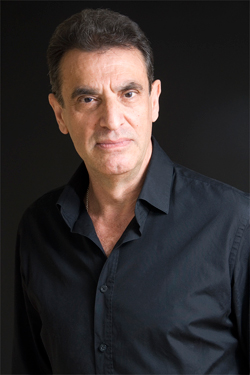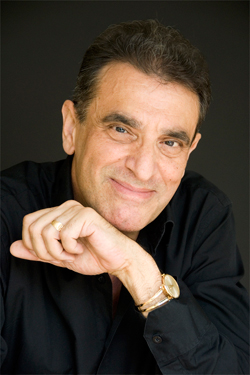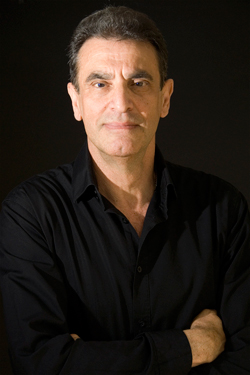|
Interview with... |
|
On the southern slope of the Sierra de Guadarrama de Madrid lies the town of San Lorenzo de El Escorial. There you find me with my interviewee Enrique Baquerizo, facing the Monastery built by Philip II in the sixteenth century. On a cold November day, the Hotel Miranda is an inviting place for Enrique to share with me his views on zarzuela.
Life is full of surprises. Today we discovered that we met long ago, for Enrique and I coincided for several years while studying in the Madrid’s College of Telecommunications Engineering. He later chose to study at the College of Singing in Madrid before being awarded a scholarship, following an audition, to complete his Masters at the University of Michigan. There he met another fine baritone – Carlos Chausson – who embarked on a parallel career. Ten years in the United States yielded many things beyond improving their musical and vocal skills, as they supported themselves by performing in restaurants and singing with the university tuna.
His debut came with Pagliacci (Silvio) in Detroit, after which operatic success followed in Il barbiere di Siviglia (Figaro), Don Giovanni (Don Giovanni), Lucia di Lammermoor (Enrico), Le nozze di Figaro (Figaro), Gluck’s Armide (Hidraot), Tosca (Scarpia), Madama Butterfly (Sharpless)…. His Spanish repertoire encompasses Goyescas, Divinas palabras, Babel 46, Katiuska, La tabernera del puerto, El gato montés, Don Gil de Alcalá, La generala, La verbena de la Paloma, La canción del olvido, La gran vía, La revoltosa and many other zarzuelas; and he has performed in the USA, Australia, Canada, Japan, UK, France, Italy, Germany, Argentina, Puerto Rico, Mexico, the Netherlands and elsewhere.
Enrique has recently been appearing in the Teatro de la Zarzuela’s new La Verbena de La Paloma in the role of Don Hilarion...
 Enrique, what are the differences between Don Hilarión
under José Carlos Plaza and the character we usually
see?
Enrique, what are the differences between Don Hilarión
under José Carlos Plaza and the character we usually
see?
There are nuances that he has sought to highlight in
this production, including the environment and poverty of that time in the
Madrid barrio where the action happens. That same environment, many
years later, was where I was born. Regarding Don Hilarión, he wanted to
bring out more richness of nuance, making him more despotic and with a certain
sadism. It is a role usually given to good actors, but not always to good
singers. It’s a shame, because it has good music that deserves to be well
sung by either a comic tenor or a bass, as the score directs.
Do you think the audience accepts
the different visions of a work or a character, has the stage
director?
The zarzuela audience is quite traditional and
generally has to work hard to accept innovation. Teatro de la Zarzuela has long
been commissioning stage direction from directors who come from other areas,
such as classical theatre or cinema, who offer their particular versions of the
repertoire. One may or may not happen to like these diverse views from
different directors, but to compare and contrast is always enriching.
(Enrique has played the protagonist in Don Quijote by Cristobal Halffter, Falla’s El retablo de maese Pedro, Chapí’s La venta de Don Quijote, and Don Quijote en Barcelona by José Luis Turina – as well as performing the Don Quixote song cycles by Maurice Ravel and Jacques Ibert.)
Having sung and performed the character of Don Quixote many times, am I allowed you to give you the nickname “The Quixote of Music”?
Admittedly I have participated in several works in which Don Quixote was the main character. Of course I do not mind, it’s an honour.
How do you see the zarzuela? Do you
have a diagnosis for her?
When I returned from the United
States I saw that the musical and technical skill of the singers had advanced
in a remarkable way compared to when I left, but that the acting aspect had
been slightly forgotten. I think that improvement in this area is critical to a
genre in which the singer/actor plays such an important role. Making both sides
go together is no easy task, though.
I also believe that zarzuela is a victim of this common habit we have of undervaluing what is under our noses. And I do not forget the lack of official support in some communities...
How do you imagine the zarzuela in a
few years?
La Zarzuela is very deeply connected to the
people – the community – and so there’s no way it will
disappear; but we will see it evolve and change through the distinctive views
that different directors take on the repertoire. It will adapt in order to
remain accepted by younger people, who are the audiences of tomorrow.
 After singing Goyescas in
London, El Retablo de Maese Pedro in
New York, La generala at Le Chatêlet in Paris, El gato
montés in Tokyo, La vida breve in Montreal, among many
others… is Spanish lyric theatre established outside the
Spanish-speaking world?
After singing Goyescas in
London, El Retablo de Maese Pedro in
New York, La generala at Le Chatêlet in Paris, El gato
montés in Tokyo, La vida breve in Montreal, among many
others… is Spanish lyric theatre established outside the
Spanish-speaking world?
No doubt it is. Outside
Spanish-speaking countries I have experienced huge public acceptance. Not only
of stage works, but Spanish music in general. It is one of our most important
cultural assets.
Just as an example to prove that Spanish music is loved worldwide, I remember while living in New York that I received a call from the director of the Saint Louis opera company in Missouri, saying that he had fallen in love with La verbena de la Paloma and wanted to programme it for the next season with me singing Julián – in English. The audience loved the music but did not understand the plot too well. That teaches us that with such specific, traditional works, the best we can do is leave them as they are. I would not want to see Porgy and Bess translated into Spanish.
What can we import from other
countries like USA, UK...?
We could spend much time talking
about this, but let’s say there are basic differences. From these
countries we could import the care that’s taken to mould the singer/actor
and respect for the profession itself, as well as improving the state of
funding.
Pedro Gomez Manzanares 18/XI/2013
 |
Coffee and tea have sustained us for this interview. Cold awaits us in the street, but it is time to finish. Thanks to Enrique for allowing us to discuss these issues. © Pedro Gómez Manzanares 18/XI/2013 |
![]() en español
en español![]() La verbena de la Paloma (Madrid 2013)
La verbena de la Paloma (Madrid 2013)![]() zarzuela
homepage
zarzuela
homepage
26/XI/2013
